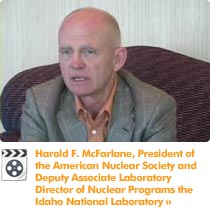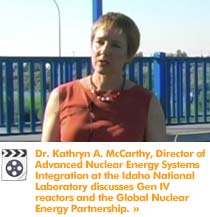

Is Nuclear Sustainable?
While the exact amount of untapped oil reserves remains in dispute, it is accepted that most of this supply lies outside of the United States and is therefore always at risk. From an energy security standpoint, then, coal remains the largest fossil fuel resource in the U.S., though by no means the cleanest. But what of nuclear?
With coal reserves estimated at a 250-year supply, the debate between nuclear and coal advocates rages. Some suggest that with less than 50 years of uranium available, why should nuclear technology even be considered. The facts, however, lie somewhere in between.
“When people say well the supply is limited, they are really talking about the known reserves or the highly reliable reserves,” states the INL’s Harold McFarlane. “There are a lot of unconventional resources that could be tapped under the right conditions.”
Many of the predictions are based on the current Gen II fuel cycle, which McFarlane reminds is very wasteful. “We dig up a lot of uranium ore in order to extract the uranium and manufacture fuel for the way we use it today, but we only use less than one percent of it. So the rest of it is either set aside or thrown away,” he explains.
Estimates will vary, especially when comparing the older Gen II reactors, whose relatively inefficient use of uranium accounts for more than 90-percent of wasted energy content. The future Gen IV reactor designs promise much more thorough burning of a range of nuclear fuels, changing the dynamic considerably.
Gen IV reactors, such as General Atomics’ GT-MHR concept, combined with the potential offered by the Global Nuclear Energy Partnership (GNEP) as a system for safely and securely reprocessing nuclear fuel, could open the door on a long-term nuclear solution to the world’s increasing energy demands.
Based on estimates published by the Nuclear Energy Agency in 2002, using only light water reactors (LWRs) to sustain the current world electricity demand, the available nuclear fuel would last just about 325 years. Using LWRs to support the world’s current hydrogen production, in addition to current electricity production rates, would cut that supply to around 190 years.
However, if LWRs were used to support half of all the world’s energy needs, the NEA estimates that the nuclear fuel supply would be expended within a short 10-year span. Even with recycling, the world’s nuclear resources would only be extended by about 10 percent.
Taking advantage of future Gen IV reactors and fuel recycling technology, these power plants could extend the world’s nuclear fuel supply to 38 years while still providing half of the world’s energy needs. But making use of both Gen IV and fast breeder reactors, half of the world’s energy needs could be met solely through nuclear power for approximately 350 years, according to the NEA.
Entire contents © 2006 Corland Publishing. Use of editorial content without permission is strictly prohibited. All Rights Reserved. Privacy Policy Legal Contact Us. Site developed by ICON.




